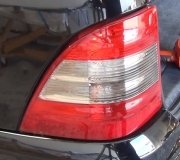There's up to three switches that can turn on the red warning light. First pull up on the parking brake pedal. If the light goes off, a cable is sticking or stretched and it's not pulling the pedal all the way to the released position.
Next is the low fluid switch. Check the level in the master cylinder reservoir. If it is low, just add a little. Do not fill it to the top. There is either a leak that must be addressed, or the front disc brake pads are worn and in need of replacement. As they wear, the self-adjusting feature causes the pistons to move out of the brake calipers, and brake fluid fills in behind them. Those pistons have to be pushed back in to make room for the new, thicker pads, and doing that pushes the brake fluid back up to the reservoir. If someone filled the reservoir previously, that fluid is going to spill out and make a mess. Brake fluid eats paint too. Not all vehicles have this low fluid switch. Also, be very careful to not get the slightest hint of any petroleum product like engine oil or power steering fluid mixed in with brake fluid. That will lead to a very expensive repair bill.
The third switch is the "pressure-differential" switch. It responds to a difference in pressure in the two hydraulic systems. That will be caused by a leak in one of those systems or a defective master cylinder. This one is probably the least likely to turn on the warning light. If you haven't found the cause by now, you can unplug each switch one at a time to see which one is responsible.
Saturday, September 21st, 2013 AT 1:24 AM



